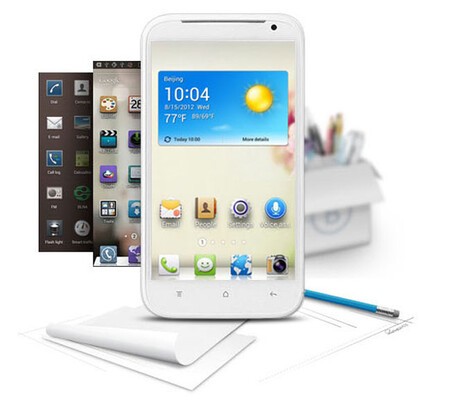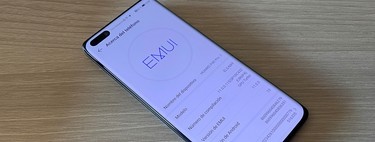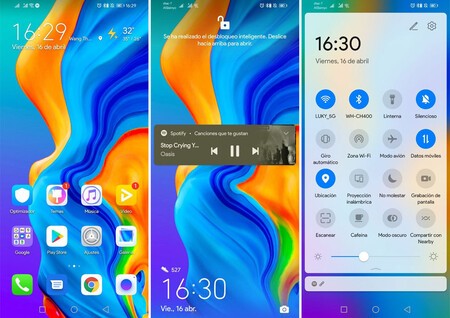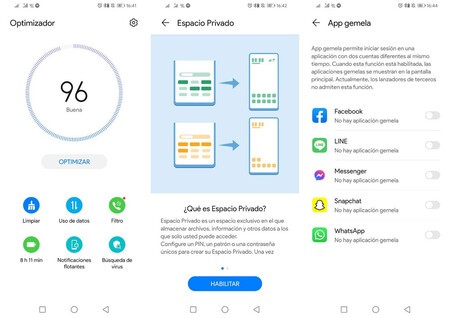The customization layer is the proprietary software that manufacturers add on top of Android, including changes to the design, applications and services. Today we will talk about EMUI, Huawei’s customization layer and, formerly, also of Honor mobiles.
First, we will summarize the history of EMUI, and then go into detail about what EMUI is like, what applications and services are included, what is the latest version available and which phones will be updated to this version.
Breve historia de EMUI
EMUI was born in 2012 as Huawei’s customization layer and under the name Emotion UI. It debuted on the Huawei Ascend P1, presenting itself as possibly “the most emotional operating system.” One of the advantages over the Android without modifications that Huawei mounted previously is that many more were added customization options, including themes and icons.
In the beginning, EMUI was Emotion UI: the most “emotional” layer debuted on the Huawei Ascend P1 in 2012
EMUI -or Emotion UI- debuted with voice control in its Chinese version, the Huawei Cloud services and widgets customizable in the style of the HTC, which were fashionable at the time. At that time, there was still a lot of scheumorphism in the design of the icons, although the design of some of them is not very different from what we have today.
 EMUI when it was still called Emotion UI
EMUI when it was still called Emotion UI In the following years, there were updates to an EMUI that took inspiration from both Xiaomi MIUI and Apple’s iOS. In EMUI 3.0, for example, the app drawer was removed by default, so all application icons were included on the home screen.
Over time, EMUI managed to find its own identity with successive changes and readjustments in its design, especially after EMUI 9 and culminating in EMUI 11. Just then, the US veto of Huawei crossed its path. Without access to Google services, the company thinks make the leap from EMUI to HarmonyOS sometime in 2021, so EMUI will disappear before it can celebrate its 10th anniversary – no EMUI 12 expected.
This is EMUI
The best way to describe EMUI is with the phrase “a Chinese layer”, although this description is not as exact in the most recent versions. Over the years, EMUI has turned its design to something more like Material Design, although there is still a certain aftertaste of Chinese design, with smaller elements and more condensation of the content.

EMUI se considera a fairly custom Android layer, in which a good part of the elements have been modified to a lesser or greater extent. Not only are the personalized styles and themes, the own applications and services or the elements of the settings and menus that change places, but the system has important changes inside that bring developers and users headlong, such as the aggressive management of Battery.
EMUI started out as a very Chinese Chinese layer, but over time it has assimilated some Material Design, also keeping inspiration from iOS
Currently, EMUI gives you the option to use it according to your preferences: with or without app drawer either with or without gestures. The lock screen is not much different from the rest, although it incorporates the infamous change of covers and shortcuts to activate the recorder, calculator, flashlight and other shortcuts by swiping up. Notifications and shortcuts are almost like on pure Android.

As an overloaded Android layer, EMUI includes more things than what comes in pure Android, and therefore you have to find where to place them in the settings menu. The result is the same in almost all layers: a settings menu very yours, with more elements than there are in pure Android.
The app drawer still has some inspiration on iOS -which is ironic, since iOS does not have it- and the recent view shows a carousel of horizontal screens, with an always visible button to open an application in split screen.

In short, EMUI is something like Android with a pinch of iOS and another of Material Design, applications and own tools and two souls living in the same body: Google Play services and Huawei. The result is more functional than chaotic reality suggests.
Featured EMUI apps and tools
EMUI was always a functional system without Google, because in its home, China, these pre-installed services are not included. As a consequence, it includes your Own alternative for all Google applications and services. In this way, mobiles with EMUI have their own phone dialer application, calendar, clock and other basic applications of the terminal.
EMUI includes its own version of all the basic apps (calendar, gallery, music) and many of its own functions
In the pre-veto mobiles there was therefore two apps to do the same: Google Photos and Gallery, Music and Google Play Music, Calendar and Calendar, Files and Files and so on.

Of course, not all are duplicities. EMUI adds a good amount of own tools, applications and services that become an added value for those who have a brand mobile. These are some of the unique features and applications of EMUI:
-
App lock: a simple way to avoid that an application can be opened unless you enter the password, PIN or fingerprint, and that works independently of the launcher.
-
Safe– A mode built into the operating system to hide photos, videos or any other file from prying eyes. The only way to access them is to use the password, PIN or mobile biometrics.
-
One hand modeEMUI includes a one-handed use mode that is activated by sliding your finger to the side from the navigation bar, and that reduces the size of the screen so that you can easily reach all the extremes.
-
Optimizer– EMUI includes an all-in-one tool to clean junk files, filter spam calls, scan for viruses, close apps to save battery, and other optimizations.
-
Twin app: it is a native way of EMUI to create clones of messaging applications to be able to use several accounts in the same mobile. It is compatible with WhatsApp, Messenger, Facebook, Snapchat, LINE and similar applications.

-
Topics: available as a standalone application, from Themes you can download wallpapers, icons and themes to customize the appearance of a large part of the mobile, including the lock screen.
-
HiVision: It is something like Huawei’s Google Lens, allowing you to scan QR codes, translate texts with the mobile camera, recognize objects and search for similar products for sale.
-
Scheduled power on and off: A curious option of EMUI is that the mobile can be turned off and on at a specific time by itself. What’s more, the mobile will turn on only before the first alarm you have configured, if you configure it in the shutdown menu.
-
Tape recorder: EMUI includes its own voice recorder that, although not as advanced as Google’s, is functional and can be used to record calls natively, with a little trick.
-
Mirror: Another curious EMUI application is Mirror, which uses the mobile camera to act as a mirror. It is more useful than it seems, it includes a zoom function, a brightness control, it can be paused at any time and it has a broken glass effect if you “squeeze it too much”.
Latest version of EMUI and compatible mobiles

As of today, the latest version of EMUI available is EMUI 11, which was officially announced in September 2020 and which, curiously, is based on Android 10. EMUI 11 does not incorporate radical changes, but focuses on offering more customization options, news in its own apps (App Gallery and company) and privacy improvements such as one-time permissions.
It is expected that EMUI 11 is the latest version of EMUI until HarmonyOS takes over, although there could be an EMUI 11.1 bridging in between. At the moment, the future of EMUI is in the air and, above all, pending to see what happens with HarmonyOS, the American veto and other associated dramas. The phones compatible with EMUI 11 are the following: